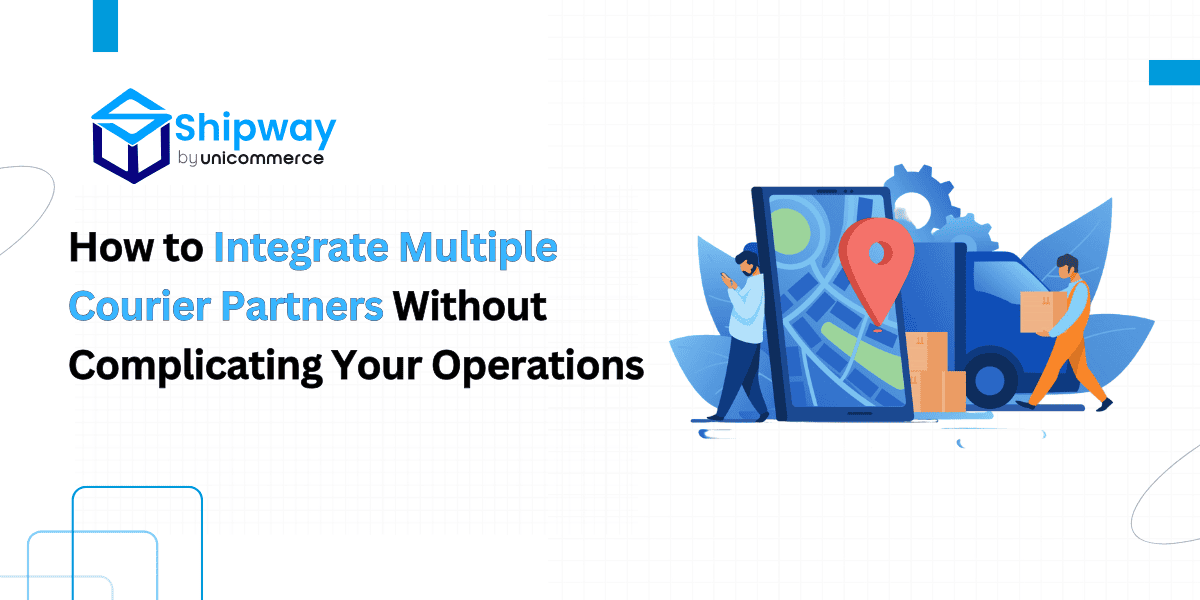When your ecommerce business starts scaling, depending on a single courier partner is no longer enough. Sellers today handle their business with multiple courier partners to get better delivery coverage, negotiate competitive rates, improve service levels, and reduce RTOs. It’s a smart strategy, especially when you’re shipping across zones, managing COD orders, or dealing with high volumes during sales and festive seasons.
But without proper courier integration, this setup can get complicated, like logging into different courier panels, uploading orders manually, tracking packages separately, and reconciling reports. These entire processes hamper time, cause dispatch delays, and increase the chances of human error.
That’s why smart courier integration is a must for scaling operations. It brings all your shipping partners into one system so you can automate workflows, assign couriers intelligently, and manage deliveries with full visibility and zero challenges.
In this blog, we’ll walk you through how to integrate multiple courier partners the right way, so you can streamline your shipping process, scale efficiently, and deliver better customer experiences at every stage.
Why Does Your Business Need Multi-Carrier Shipping?
Using multiple courier partners, often managed through a multi-carrier shipping platform, offers a wide range of benefits for businesses, especially those involved in e-commerce. Here’s a breakdown of the key advantages:
- Cost Savings: Different couriers offer varying rates for different routes, package sizes, and service levels. By having multiple partners, you can compare prices for each shipment and choose the most cost-effective option, leading to significant savings over time.
- Increased Flexibility and Adaptability: Having multiple partners allows you to cater to a wider range of customer needs and product requirements. You can choose the best carrier for each specific route, whether it’s for local, national, or international shipments, ensuring optimal transit times and costs.
- Expanded Reach and Coverage: By partnering with multiple services, you can significantly expand your reach, accessing both urban and rural areas.
- No Customer Left Out: You won’t have to turn away customers based on their location, increasing your potential customer base and sales.
- Faster and More Reliable Deliveries: With access to various delivery speeds and options from different couriers, you can select the fastest possible delivery service for urgent shipments or offer a range of delivery times to your customers.
- Enhanced Customer Satisfaction: Offering various shipping options (speed, cost) allows customers to choose what best suits their needs and budget, leading to a more positive shopping experience.
- Streamlined Operations (with a Multi-Carrier Platform): Advanced multi-carrier platforms can automatically select the best carrier for each shipment based on predefined rules (cost, speed, performance, etc.). You can manage all your shipments, labels, and tracking from a single dashboard, simplifying logistics operations.
Therefore, implementing a multi-courier strategy, especially with the aid of a shipping aggregator platform, empowers businesses to optimize their shipping process, reduce costs, expand their reach, and ultimately, deliver a superior customer experience.
How to Choose the Right Multi-Shipping Partner
Once you decide to work with multiple courier partners, the next big step is finding the right tool to manage them all. A courier aggregator isn’t just about connecting to shipping partners, it’s about automating the entire post-order process.
The wrong platform can create more chaos with manual work, limited courier options, or missing features like tracking and reconciliation. But the right aggregator can centralize your shipping operations, cut down delays, reduce returns, and give you the visibility you need to scale smoothly.
Whether you’re a growing D2C brand or an enterprise seller with multiple warehouses, choosing the right software makes all the difference between shipping chaos and a streamlined, profitable logistics operation.
Key Features to Look for in Courier Aggregator Software
Whether you ship 100 or 10,000+ orders daily, choosing the right courier aggregator can make or disrupt your post-order experience. Here are the must-have features to look for:
1. Multi-Courier Integration
Seamless integration with top national and regional courier partners, allowing you to assign shipments based on zone, cost, or delivery speed.
2. Smart Courier Allocation Rules
Auto-assign couriers using logic like lowest rate, fastest TAT, COD support, zone performance, or weight slab, no manual decision-making.
3. Real-Time Rate Comparison
Get live shipping rates across partners in one view, helping you optimize cost per shipment.
4. Unified Shipping Dashboard
Track, manage, and monitor pickups and deliveries across all courier partners in one centralized dashboard.
5. One-Click Label Generation
Generate AWBs, shipping labels, and manifests in bulk, directly synced to your OMS or WMS.
6. NDR & RTO Management
Proactive NDR workflows with customer notifications, courier follow-ups, and auto-escalations to reduce returns.
7. Real-Time Shipment Tracking
Centralized tracking with branded tracking pages and buyer notifications via email, SMS, or WhatsApp.
8. Performance Analytics
Access courier-wise performance reports, track delivery times, RTO rates, and zone-wise SLA breaches to make data-backed decisions.
9. API & Platform Integrations
Plug-and-play with your existing ecommerce stack, Shopify, Magento, WooCommerce, marketplaces, ERPs, and OMS platforms.
10. COD Remittance Reconciliation
Automate reconciliation of COD payouts and settlement reports across couriers- no more spreadsheet headaches.
11. SLA & Exception Handling
Set SLAs, alerts, and fallback rules for missed pickups, delayed deliveries, or in-transit issues.
12. Customer Support Automation
Pre-built workflows for WISMO queries, delay notifications, or delivery feedback, cutting support tickets and improving CX.
Whether you’re fulfilling 100 or 10,000+ orders a day, integration helps you scale without adding operational chaos. It’s not just a tech upgrade, it’s a growth enabler.
5 Common Mistakes to Avoid When Managing Multiple Courier Partners
While working with multiple shipping partners offers flexibility and reach, it also brings operational challenges that can disrupt workflows and affect profitability. Brands that fail to integrate multiple couriers using the right shipping software often struggle with delays, errors, and rising costs.
To help you avoid these pitfalls, here are the most common mistakes sellers make and how logistics automation can solve them for smoother, more efficient operations.
1. Manually Assigning Couriers for Each Order
Assigning courier partners manually takes up time, increases the risk of human error, and limits your ability to optimize shipping based on speed or cost. Instead, set up courier allocation rules based on factors like delivery zones, order value, payment method (COD/prepaid), or past performance.
2. Managing Multiple Courier Dashboards Separately
Switching between different courier partners to track shipments, generate labels, or raise issues creates confusion and operational delays. Using a centralized platform allows sellers to manage all courier operations from a single dashboard.
3. No System for Handling Delivery Failures (NDRs)
When failed delivery attempts (NDRs) aren’t addressed promptly, it leads to higher return rates and unhappy customers. Implementing an NDR workflow that automatically triggers customer follow-ups and reschedules delivery attempts can significantly reduce RTOs and improve delivery success.
4. Lack of Real-Time Tracking and Customer Communication
Not providing tracking updates can result in frequent support queries and a poor post-purchase experience. Enabling real-time tracking and sending automated notifications via email, SMS, or WhatsApp helps keep customers informed and builds trust in your brand.
5. Not Monitoring Courier Performance
Without courier-level performance tracking, issues like delays, high RTOs, or SLA breaches often go unnoticed. Sellers should regularly review performance reports to identify underperforming partners and adjust courier allocation strategies accordingly.
How Shipway Simplifies Shipping for D2C Brands
As D2C brands scale their business, managing multiple courier services manually can slow things down and increase the chances of errors. What they need is a system that connects everything without complicating their operations.
Shipway’s plug-and-play courier aggregator system lets you integrate and manage multiple shipping partners through one unified platform, saving time, reducing manual effort, and giving you complete visibility over your logistics.
1. One-Click Multi-Carrier Integration
Shipway functions as a central logistics hub, allowing you to connect with multiple courier partners through a single interface. You don’t have to manage each integration separately; Shipway handles all API connections on the backend for you.
2. Centralized Dashboard for All Orders
Manage and track shipments from various sales channels in one place. Orders from your website, marketplaces, and apps are automatically synced, enabling you to assign couriers and monitor fulfillment from a single dashboard.
3. Developer-Friendly API Support
Shipway offers flexible APIs to support both channel and courier integrations. This makes it easier to plug into your existing tech stack and dynamically switch between partners as needed.
4. Pre-Negotiated Courier Rates
Access a wide range of trusted courier services with pre-negotiated rates, giving you the flexibility to choose the most cost-effective and reliable options without lengthy onboarding processes.
5. Native Integrations with Ecommerce Platforms & Marketplaces
Shipway integrates seamlessly with platforms like Shopify, WooCommerce, Magento, and marketplaces like Amazon and Flipkart, reducing development time and simplifying order flow.
6. End-to-End Workflow Automation
From label generation and order allocation to shipment tracking and return processing, Shipway automates repetitive tasks, improving operational efficiency and reducing errors.
7. Intelligent Courier Allocation
Automatically assign the best courier for each order based on predefined rules—like destination, delivery SLA, shipping cost, and pin code coverage, ensuring every shipment is optimized for performance.
8. Real-Time Tracking and Customer Notifications
Enable live shipment tracking and send automated status updates via SMS, email, or WhatsApp. This enhances the post-purchase experience and reduces support queries.
Conclusion
Managing deliveries through multiple courier partners brings clear benefits—wider reach, faster deliveries, and greater control over costs. But to truly make it work, ecommerce businesses need more than just access to multiple carriers; they need a system that brings structure and efficiency.
Without the right shipping software, handling multiple partners can lead to delayed dispatches, tracking errors, and rising operational overhead. That’s why brands looking to scale must focus on how they integrate multiple couriers into a single, streamlined workflow.
If your order volumes are increasing, service areas are expanding, or you’re seeing a rise in returns, it’s a good time to re-evaluate your shipping approach. A well-integrated courier setup not only improves day-to-day logistics but also ensures a consistent customer experience, healthier margins, and fewer operational bottlenecks.
A
What exactly is ecommerce shipping integration?
It’s a software connection between your online store and shipping carriers. This automates tasks like rate calculation, label printing, tracking updates, and inventory syncing so you don’t have to switch between platforms manually.
Why should I add shipping integration to my store?
- Save time & costs by automating repetitive tasks.
- Reduce errors with automated label generation.
- Improve transparency through real-time shipment tracking.
- Enhance flexibility by offering customers multiple delivery options.
How does real-time carrier rate calculation benefit my business?
Instant rate quotes at checkout let customers choose based on cost or delivery speed. Plus, you avoid overcharging or underestimating shipping fees.
Can shipping integration handle returns, too?
Absolutely. Strong solutions streamline returns by auto-generating labels, tracking inbound shipments, and updating inventory, creating a smoother experience for both your operations team and customers.
Which platforms support shipping integrations?
You’ll find built-in or app-based support for leading platforms such as Shopify, WooCommerce, BigCommerce, Wix, and more. Many integrations plug in easily without extensive coding.



